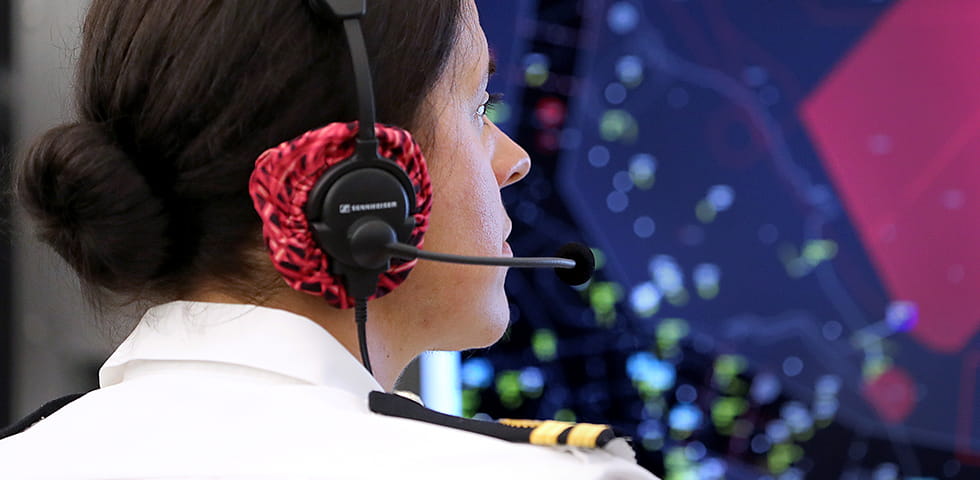Air Traffic Control Officer
Whether on board a ship or onshore, you’ll help keep the skies safe and lead the team that ensures safe flow of air traffic.
- £31,000 - £110,500
- A-Levels / college qualifications
- Fleet Air Arm
- Aviation
- Officer level
£31,000
The minimum you'll earn after training
£110,500
As you progress through your career
0%
Free
7 weeks
Travel

It’s really important that I’m organised, focused and have 100% concentration. Knowing that the lives of my mates are in my hands is a level of responsibility I’d struggle to find elsewhere.
Role details
What you’ll do
It’s not just the air space directly above you that you’ll be responsible for. You’ll control the flow of air traffic for a 30-mile radius. Given this could be anywhere in the world depending on where your missions take you – with civilian and private traffic, extreme weather and potential conflict to consider – you’ll need to be completely on the ball. Whether you’re in the middle of the ocean on board an aircraft carrier like the new Queen Elizabeth, or on shore at a Royal Naval Air Station, the lives of your crewmates will be in your hands.
Your role
- Monitor the airwaves and make sure each and every one of the helicopters and jets under your watch lands safely.
- Use your knowledge of our world-class kit, and understanding of your environment, to give clear instructions to pilots and crew.
- Operate sophisticated radar and communication systems, and collaborate with everyone in your team.
- Use your world-class communication skills to ensure the safety of your crew.
Pay & benefits
- A starting salary in excess of £31,000
- Rising beyond £38,500 after two years
- Accelerated training and responsibility from day one
- Seven weeks of paid holiday every year
- Free medical and dental care
- Subsidised travel and accommodation
- Adventurous training
- Excellent pension scheme
Skills for life
Qualifications you'll gain
- Study for GCSEs, A-Levels, NVQs or even a degree, with funding from us
- Gain specialist vocational qualifications
- Gain a Foundation Degree in Airspace Management on completion of professional training
Skills you'll develop
- How to use state-of-the-art equipment to monitor your airspace and keep it safe
- The art of effective communication and decision-making in high-pressure situations
Eligibility
- You must be aged 18 to 34
- You’ll need a minimum of 72 UCAS points. These can be accrued from either GCE A/AS Levels (or equivalent) or National Diplomas (e.g., BTEC)
- You’ll need at least 5 GCSEs at grades A*-C (9-4) (or Scottish equivalent), which must include English language and Mathematics
- You must be a United Kingdom citizen or British Dual United States National to apply. Dual Nationality restrictions do apply
- You must have lived in the UK for 5 years continuously prior to application
- Minimum height of 151.5cm
- A Body Mass Index (BMI) between 18 and 28 (between 17 and 27 if under 18)
- Must pass CBAT. Specialist Aviation Medical at OASC, RAF Cranwell post AIB.
Skills & interests
- Able to thrive on responsibility
- A confident leader
- A passion for working as part of a team
- Calm under pressure
- Able to concentrate for long periods of time
Joining process
From picking your role to the first day of training; everything you need to know as an officer
Submit an application
Defence Aptitude Assessment (DAA)
You’ll be tested on: Verbal Reasoning, Numerical Reasoning, Work Rate, Spatial Reasoning, Electrical Comprehension and Mechanical Comprehension.
To prepare, you can practise the DAA
Interview
Medical and eye tests
Pre-Joining Fitness Test (PJFT)
Interview
Admiralty Interview Board (AIB)
This stage is unique to officers and takes place in two parts. A Pre Recorded Interview (PRI) is an online assessment which assesses your motivation to join the Royal Navy as an officer and your awareness of the Royal Navy. The Group Planning Exercise (GPE) is the second stage of the AIB and is an online competency based assessment which will take place on a separate day to the PRI. It will be conducted in a virtual group environment and you will be assessed on your contribution to the team based on your individual performance.
Career progression
Before you begin your initial training, you’ll need to take Flying Aptitude Tests (FATs) at RAF Cranwell in Lincolnshire. These assess your ability to cope with the rigours of flying training.
You’ll then progress to Britannia Royal Naval College (BRNC) in Dartmouth, where you’ll spend 30 weeks, focusing on: military skills, maritime skills and initial fleet time.
After you’ve passed out of BRNC, you will spend a further 15 weeks learning about how our equipment works. At the end of this stage, you’ll go through grading. This is a set of tests that determines your suitability for your specialisation.
Once you’ve completed grading, you’ll begin your professional training at RAF Shawbury in Shropshire. Throughout this 24-week course, you’ll use state-of-the-art simulators under the guidance of our experienced instructors.
you’ll go to either RNAS Yeovilton, RNAS Culrose, or RAF Marham, where you’ll spend 34 weeks gaining hands-on experience working with real aircraft. At the end of this, you’ll gain your Certificate of Competency and be a fully qualified Air Traffic Control Officer.
Got a question?
Our virtual recruiter is available to answer your questions 24 hours a day
